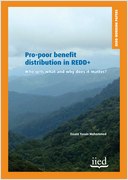Pro-poor benefit distribution in REDD+
-----------------
Equitable benefit sharing issues at a community or household level are overlooked in both academic and non-academic literature compared to distributional issues at international level. Therefore, this paper aims to look at some of the issues related to benefit distribution at village and household level. Some of the very important factors that are very likely to affect benefit distribution from REDD+ at a village level are
(1) whether payments are made directly to households or to communities as a whole; and
(2) whether payments are made in cash or in-kind.
In addition the paper looks at the following design issues closely related to the above two questions: what should the provision of benefits be based on? Land size, actual emission reductions, or demography of the community to ensure that equitable design criteria are met; how to ensure that more vulnerable groups such as ethnic minorities, landless poor, women and children do not lose out? And what impact would the type of benefit transferred have on the wellbeing of the communities and local economy?
---------------

